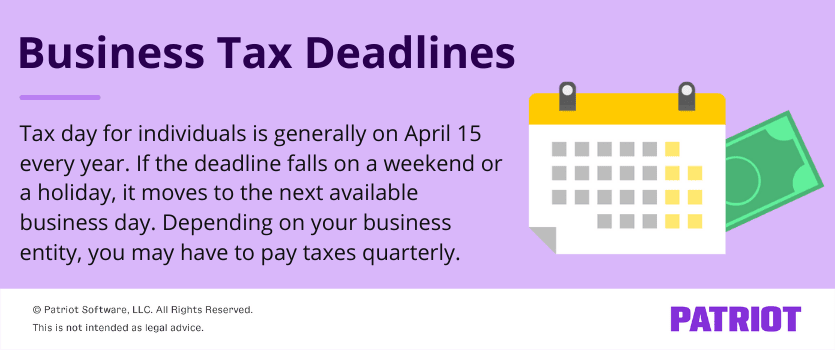It’s that time of year again when tax filing deadlines bear down on small businesses across the country. Don’t get caught off guard this year. Read on to learn all about the deadlines for taxes.

Business tax deadlines
Tax Day (aka the day individual income tax returns are due) is on April 15 every year. But Tax Day is moved to the next available business day if it falls on a weekend or a holiday. In 2025, April 15 falls on a Tuesday.
Tax Day 2025 is on Tuesday, April 15.
But, different business structures may have different business tax deadlines.
Business structures can include:
Sole proprietorship
Sole proprietors aren’t legally separate from their business, so they file their business and personal taxes at the same time.
Sole proprietors must use Schedule C, Profit or Loss For Business, to file business income and deductible expenses for the tax year. If you are a sole proprietor, attach Schedule C to Form 1040, U.S. Individual Income Tax Return. The deadline to file Form 1040 is April 15.
Sole proprietors that have no employees and are self-employed must also attach Schedule SE and Form 1040-ES to their Form 1040. If you’re a sole proprietor without any employees, use Schedule SE, Self Employment Tax, to pay self-employment taxes on profits. Also, use Form 1040-ES, Estimated Tax for Individuals, to calculate and pay estimated taxes quarterly.
Check in with the IRS if you need more information about estimated taxes.
To help make it easier to remember the forms and deadlines for sole proprietors, take a look at our handy chart.
| Does the Sole Proprietor Have Employees? | What Form Should Be Used? | When Is the Form Due? |
|---|---|---|
| Yes | Form 1040 Schedule C* | April 15 |
| No | Form 1040 Schedule C* Schedule SE | April 15 |
| No | Form 1040-ES | File Form 1040-ES and pay all of your estimated tax by April 15, or pay in four equal amounts on these dates: April 15 June 15 Sept 15 January 15 |
*If your business had no income or expenses for the past year, you don’t have to file a Schedule C for the year.
Partnership
Partnerships have two or more owners. The owners of a partnership are called partners. Each partner owns shares of the business’s profits and losses.
Like sole proprietorships, partners aren’t separate from their business. Because of this, partners are taxed at the personal income level based on how much of the business they own (e.g., their number of shares).
The partnership must use Form 1065, U.S. Return of Partnership Income, to report the profits and losses of the business to the IRS. Form 1065 is due by April 15.
The partnership must distribute Schedule K-1, Partner’s Share of Income, Deductions, Credits, and Other Items, to all partners by March 15.
If you are a partner, use Schedule K-1 to understand your share of the company’s profits and losses. Include the information from your Schedule K-1 on Form 1040. File Form 1040 to the IRS by April 15.
Check out this chart to see the different forms and deadlines for partnerships.
| Is the Filer the Partnership or the Partner? | What Form Should Be Used? | When Is the Form Due? |
|---|---|---|
| Partnership | Form 1065 Schedule K-1 | April 15 |
| Partner | Form 140 Schedule K-1* | Partners should receive their Schedule K-1 by March 15 or the 15th day of the third month after the company’s tax year ends. Partners should use their Schedule K-1 to complete Form 1040. Submit Form 1040 to the IRS by April 15. |
*Partners, don’t file your Schedule K-1 with Form 1040 unless you are required to. See IRS publication Partner’s Instructions for Schedule K-1 for more information.
Limited liability company
Owners of limited liability companies (LLCs) are separate from their business, meaning they aren’t personally responsible for business decisions or debts. But, owners of LLCs are taxed at the personal level, similar to sole proprietorships and partnerships.
There are two types of LLCs, single-member and multi-member. Both have different tax forms and deadlines to keep track of:
- Single-member LLCs are taxed the same way as a sole proprietorship. If you are the owner of a single-member LLC, attach Schedule C to your Form 1040 and submit both to the IRS by April 15.
You must pay self-employment tax if the net gain from the company exceeds $400 during the tax year. Attach Schedule SE to your Form 1040.
You may need to estimate your taxes for the year if you expect to owe $1,000 or more in taxes. Use Form 1040-ES to estimate and pay your estimated taxes. Remember that Form 1040-ES (and all estimated tax payments) are due quarterly.
- Multi-member LLCs are classified as partnerships. And like partnerships, a multi-member LLC must account for the company’s profits and the profit shares of each member.
To do this, a multi-member LLC must file a Form 1065 and each member must file a Schedule K-1 to show their share of the company’s income.
Members of a multi-member LLC don’t earn regular wages. Instead, they make their money from the profits of the company shares they own. If you are a member of a multi-member LLC, you must pay self-employment taxes on your share of company profits. Attach a Schedule SE to your Form 1065.
You may also need to estimate your taxes for the year with Form 1040-ES. Keep in mind that Form 1040-ES (and all estimated tax payments) are due quarterly.
Here is a chart explaining the forms and deadlines for limited liability companies.
| Type of LLC | What Form Should Be Used? | When Is the Form Due? |
|---|---|---|
| Single-member | Form 1040 Schedule C Schedule SE* | April 15 |
| Single-member | Form 1040-ES | File Form 1040-ES and pay all of your estimated tax by April 15 or pay in four equal amounts on these dates: April 15 June 15 Sept 15 January 15 |
| Multi-member | Form 1065 Schedule K-1 | March 15 |
| Multi-member | Schedule SE** | April 15 |
| Multi-member | Form 1040-ES | File Form 1040-ES and pay all of your estimated tax by April 15 or pay in four equal amounts on these dates: April 15 June 15 Sept 15 January 15 |
*If net gain exceeds $400 or more for the tax year, you must file self-employment tax.
**You must pay self-employment tax on your entire share of company profits, even if you leave some of your distributive shares in the business.
Corporation
The owners of corporations are considered separate from their company, which means they have limited liability. Owners of corporations are taxed at the business and personal levels.
There are two types of corporations: S Corps and C Corps. Both have different tax forms to keep track of:
- S corporations only pay taxes on personal income. Owners of S corporations must use Form 1120-S, U.S. Income Tax Return for an S Corporation. Individual shareholders must also use Schedule K-1 to detail the distributions they received from the company.
- C corporations must file Form 1120 to report profits and losses. Shareholders must also use Form 1040 to report their income.
| Type of Corporation | What Form Should Be Used? | When Is the Form Due? |
|---|---|---|
| S Corp | Form 1120-S Schedule K-1 | March 15 |
| C Corp | Form 1040 Form 1120 | The 15th day of the fourth month after the end of the company’s fiscal year |
Other IRS forms and deadlines you should know
If you are an employer, there are more IRS forms you may need to complete and file on time.
Take a look at our chart of additional accounting forms and deadlines you should know about.
| Form | Reason | Deadline |
|---|---|---|
| Form 1096, Annual Summary and Transmittal of U.S. Information Returns | Use Form 1096 to transmit paper forms 1097, 1098, 1099, 3921, 3922, 5498, and W-2G to the IRS. You cannot use Form 1096 for electronic submissions. | Possible due dates include January 31, February 28, and May 31, depending on the form you’re summarizing. |
| Form 1099-NEC, Nonemployee Compensation | Use Form 1099-NEC to report nonemployee compensation, such as fees, commissions, prizes, and awards. | File on or before January 31. |
| Form 1099-MISC, Miscellaneous Information | Use Form 1099-MISC to report miscellaneous payments, such as royalties, rents, prizes or awards, and nonqualified deferred compensation. | File a paper copy of Form 1099-MISC, on or before February 28. For electronic copies, file before March 31. |
| Form W-9, Request for Taxpayer Identification Number and Certification | Independent contractors use Form W-9 to provide employers with information, such as payments for services. The information on Form W-9 helps employers prepare Form 1099 at year-end. | There is no deadline for Form W-9 because you don’t need to send it to the IRS. Keep the form in your records and use it to fill out Form 1099-NEC. |
Keeping track of tax forms and deadlines is enough to make your head spin. Make accounting easier than ever with Patriot’s online accounting software. With Patriot, you get intuitive software that doesn’t require training to use. Get started with our easy onboarding startup wizard and free USA-based support. Try it for free today!
This article has been updated from its original publication date of February 8, 2023.
This is not intended as legal advice; for more information, please click here.






